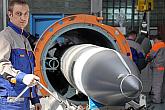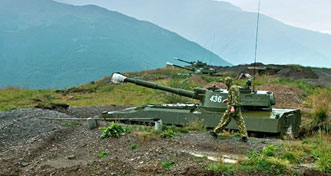Russian ICBM missile tests: What lies behind U.S. allegations?

The RS-26 Rubezh is an intercontinental ballistic missile, meaning that it follows a ballistic trajectory to reach the target. Source: Sergey Kazak / RIA Novosti
The United States has informed its NATO allies of American concerns over a possible breach of the Intermediate-Range Nuclear Forces Treaty (INF) by Moscow. According to the U.S. media, these concerns were triggered by Russian cruise missile tests. RBTH has asked prominent military expert Viktor Litovkin to explain the situation.
The INF Treaty bans the production, testing and deployment of intermediate-range (1,000-5,000 km) and shorter-range (500-1,000 km) ground-based ballistic and cruise missiles by the United States and Russia.
Judging from reports in the American press, Washington believes that Russia tested a “suspicious” missile in 2008. The U.S. media are not saying what the missile was - but they are dropping heavy hints that we're talking about the RS-26, also known as the Rubezh and the Avangard.
The RS-26 Rubezh is an intercontinental ballistic missile (ICBM), meaning that it follows a ballistic trajectory to reach the target. Cruise missiles, on the other hand, fly horizontally just above the Earth's surface, sticking closely to the surface topography. ICBMs have a range of up to 11,500 km, whereas cruise missiles, as a rule, have a much more limited range of up to 3,500 km.
The cause of the latest ruckus is that, in a certain sense, the warhead used with the Rubezh ICBM behaves as a cruise missile in its own right. After being launched from a mobile ground-based platform, the RS-26 climbs straight upwards.
Once it has reached a certain altitude, it starts to follow a curved ballistic trajectory towards the target. Then during the descending section of that trajectory, with only a few hundred miles left to the target, the warhead suddenly takes a dive, loses altitude, and continues the approach as a cruise missile, i.e. flying horizontally along the Earth's surface. Detecting such a warhead by radars or other traditional means is impossible; neither can the warhead be intercepted.
A symmetrical response
These new Russian ICBM warheads were developed in response to America’s plans to deploy a global missile defense system along Russia's borders.
In fact, Washington was informed some time ago about the RS-26 Rubezh. Col. Gen. Vladimir Zarudnitsky, head of the Main Operations Department at Russia’s General Staff, spoke about the new missile system just over six months ago. “As part of the approved plan of augmenting the Russian armed forces, the MoD has conducted a test launch of the new Rubezh ICBM, which has greatly improved strike precision characteristics," the general said at a meeting with President Vladimir Putin.
Related:
Should Russia fear the U.S. 'Prompt Global Strike'?
The missile was launched on June 6, 2013 from the Kapustin Yar missile range in the Astrakhan Region, and landed at the Balkhash range in eastern Kazakhstan. Prior to that, another missile was launched from the Plesetsk range in the Arkhangelsk Region, landing at the Kura range in Kamchatka, some 6,300 km to the east.
According to Gen. Zarudnitsky, once the Rubezh passes the trial program it will enter service with the Strategic Missile Troops (the Russian land-based nuclear forces). The first missile regiment will begin receiving these missiles later in 2014. The MoD is now working to deploy the requisite infrastructure and train the personnel.
Offense the best form of defense?
Some specialists say that Russia may actually have tested a cruise missile designed for deployment on long-range bombers or ships and submarines. Such missiles are not banned by the INF treaty.
The snag is that the test launch of the missile was performed from a platform on the ground, since it is much cheaper than conducting the same test launch at sea or from an aircraft. Though that may have been the detail that spurred the Americans to level accusations at Moscow, their motives are probably not what they seem to be.
For example, the Americans regularly test elements of their missile defense system at the Kwajalein atoll in the Pacific. The target missiles used during these tests are equipped with engines from intermediate-range missiles.
This has been pointed out on several occasions by Maj. Gen. Midykhat Vildanov, professor at the Academy of Military Sciences and one of Russia's most respected specialists on strategic weapons systems.
In an article published in the Nezavisimoye Voennoye Obozreniye (Independent Military Review) journal last July, he accused the Pentagon of violating the INF Treaty. More specifically, Prof. Vildanov insists that during the tests of their interceptors, the Americans use target missiles that have a range of over 1,000 km (1,200 km for HERA; 2,000 km for LRALT; and up to 1,100 km for MRT missiles).
This is a clear violation of the INF Treaty. The Russian Foreign Ministry complained about this back in January 2001, and again in August 2010, but met with no response from Washington.
Meanwhile, the Russian MoD says the charges of violating the INF Treaty leveled at Moscow by the American press have coincided with an interesting statement by Defense Secretary Chuck Hagel.
Speaking at the Munich Security Conference, Hagel said that the Pentagon had sent the USS Donald Cook, a naval destroyer equipped with the Aegis missile defense system, to the Spanish port of Rota. Such coincidences are eerily reminiscent of the preventive propaganda attacks during the Cold War confrontation between the United States and the Soviet Union.
All rights reserved by Rossiyskaya Gazeta.
Subscribe
to our newsletter!
Get the week's best stories straight to your inbox


